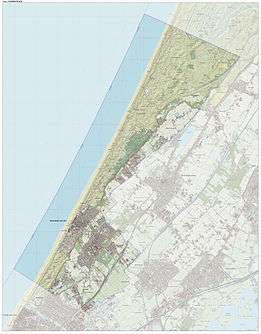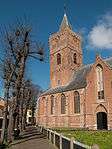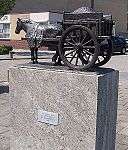Noordwijk
| Noordwijk | |||
|---|---|---|---|
| Municipality | |||
|
Aerial view over Noordwijk aan Zee | |||
| |||
.svg.png) Location in South Holland | |||
| Coordinates: 52°14′N 4°27′E / 52.233°N 4.450°ECoordinates: 52°14′N 4°27′E / 52.233°N 4.450°E | |||
| Country | Netherlands | ||
| Province | South Holland | ||
| Government[1] | |||
| • Body | Municipal council | ||
| • Mayor | Jan Pieter Lokker (CDA) | ||
| Area[2] | |||
| • Total | 51.45 km2 (19.86 sq mi) | ||
| • Land | 35.48 km2 (13.70 sq mi) | ||
| • Water | 15.97 km2 (6.17 sq mi) | ||
| Elevation[3] | 3 m (10 ft) | ||
| Population (May 2014)[4] | |||
| • Total | 25,600 | ||
| • Density | 722/km2 (1,870/sq mi) | ||
| Demonym(s) | Noordwijker | ||
| Time zone | CET (UTC+1) | ||
| • Summer (DST) | CEST (UTC+2) | ||
| Postcode | 2200–2204 | ||
| Area code | 071 | ||
| Website |
www | ||
Noordwijk (Dutch pronunciation: [ˈnoːrtʋɛi̯k]) is a town and municipality in the west of the Netherlands, in the province of South Holland. The municipality covers an area of 51.45 km2 (19.86 sq mi) of which 15.97 km2 (6.17 sq mi) is water and had a population of 25,600 in 2014.
The municipality of Noordwijk consists of the communities Noordwijk aan Zee and Noordwijk-Binnen, separated by a narrow green belt.
Besides its beaches, Noordwijk is also known for its bulb flower fields. It is located in an area called the "Dune and Bulb Region" (Duin- en Bollenstreek).
Noordwijk is also the location of the headquarters for the European Space Research and Technology Centre (ESTEC), part of the European Space Agency (ESA). ESA's visitors' centre Space Expo is a permanent space exhibition.
Noordwijk facts

- 13 kilometres (8.1 mi) coast line
- 43 kilometres (27 mi) from Amsterdam
- 25 kilometres (16 mi) from Schiphol airport
- 27 kilometres (17 mi) from The Hague
- 43 kilometres (27 mi) from Rotterdam Airport
- 14 camp sites in the region
- ± 1 million overnight stays per year
- Number of hotels/B&B beds: ± 3,400
- No. 2 congress destination in the Netherlands
- ± 251 international congresses per year
- Home to the ESA/ESTEC (European Space Research and Technology Centre)
- In 2012 Noordwijk has received the QualityCoast Gold Award for its efforts to become a sustainable tourism destination. Because of this award Noordwijk has been selected for inclusion in the global atlas for sustainable tourism DestiNet.[5]
History
A place of pilgrimage: Noordwijk’s history dates back to 2000 BC. This is when the first traces of inhabitants were recorded, with the torture of Jeroen the priest in 857. Jeroen, a Scottish Benedictine monk who came to Noordwijk in 847 to carry out his mission work and build a chapel, could have been the first priest of Noordwijk. His life came to an abrupt end in 857 when he was beheaded by ransacking Normans. His name lived on however, as more than a hundred years later in 980 a Roman chapel was built in his honour. This chapel became a popular destination for pilgrims. In 1303 a large stone church was built on the site of the chapel, known as the Middle Aged gothic Great Church, or Sint Jeroen's. Sint Jeroen's skull served as an important relic. Noordwijk soon became known as a place of pilgrimage, which was officially confirmed by the Bishop of Utrecht in 1429. Sint Jeroen's church developed over time into a pilgrims’ church, which provided Noordwijk with a considerable income. However, the Eighty Years' War put an end to this. Only by paying a substantial sum to William of Orange's army could the church be saved during the Iconoclastic Fury of 1566. To be on the safe side however, all Catholic objects were removed from the church; including the most important relic, Sint Jeroen’s skull. Tradition has it that his head lies buried somewhere in the church, but nobody knows exactly where. Towards the end of 1800 a new Roman Catholic church was erected in honour of Sint Jeroen. To this day the church's altar houses the skeletal remains of Sint Jeroen.
Fishermen: The first inhabitants of Noordwijk were most likely fishermen. The first "vierboet" was built in 1444, on the site of the current Grand Hotel Huis ter Duin. A "vierboet" is a fire site on a hill for helping the fishermen find their way back to the beach at night. Back in 1474 Noordwijk had an extensive fleet of 38 large & small ships, which left from the beach as there was no harbour. They caught herring, cod, haddock, whiting and plaice.
Bulb exhibitions: Bulb cultivation emerged as the successor to herb cultivation. From 1880 the number of bulb growers and bulb fields grew to 250 and 252 hectares respectively, by the end of the 19th century. Tulips, daffodils and gladioli were grown, amongst other flowers. The majority of bulb fields lie behind the dunes as the sandy soil there is extremely suitable for cultivation. Noordwijk earned a national and international reputation for its impressive bulb exhibitions. In 1932 a Flora park was set up within the Offem country estate. Furthermore, Noordwijk entries could be admired at foreign bulb exhibitions and subsequently also in the flower exhibitions. Today the Noordwijk bulb area covers 311 hectares of land.
Floral seaside resort of Europe: Noordwijk didn’t become a seaside resort until 1866. This was the time when seaside trips were only for the rich elite, and beach outings were very much a chic affair. Sea water was believed to have a cleansing effect. Not long after this, work started on the Grand Hotel Huis ter Duin. With the arrival of the steam tram, a visit to the seaside became a possibility for many holiday makers. The unique combination of the beach and the colourful fields of flowers ensured that Noordwijk blossomed into the ‘floral seaside resort of Europe’.
‘Zeeër’ or ‘Binner’: There have always been notable differences between coastal Noordwijk aan Zee and inland Noordwijk-Binnen. In days gone by this was due to religious and occupational differences, which were easily maintained due to the geographical differences. Noordwijk aan Zee inhabitants were by origin fishermen, with a Protestant background. The primary occupation within Noordwijk-Binnen was bulb cultivation, with Roman Catholicism being the predominant faith. During the Eighty Years' War (1568–1648) some of the ‘Geuzen’ (Protestant rebels) were from Protestant Noordwijk aan Zee. This area suffered under the Spaniards, whilst Catholic Noordwijk-Binnen was spared. This discrimination continued, and not just in a religious sense. Whilst the coastal dwelling ‘Zeeër’ fished for a living, the inland ‘Binner’ cultivated herbs and later bulbs. Until the start of the 20th century Noordwijk had a small fleet of barges at its disposal, which departed from the beach as there was no harbour. In the 19th century Noordwijk developed into a seaside resort. To this day the notion of being either a Zeeër or Binner continues, especially amongst the older generation.
Noordwijk aan Zee

Noordwijk aan Zee was founded around 1200 as a fishing village. Until the beginning of the 19th century, fishing remained its primary business, but then began to be replaced by the growing tourism industry. Nowadays because of its long sandy beaches, it is a popular resort town with 1,000,000 overnight stays per year. It has a lighthouse and a KNRM rescue station. Furthermore, it has a reformed church (1647) with a pulpit from the 17th century.
Noordwijk aan Zee is rated as the 12th richest location in the Netherlands. Beer magnate Freddy Heineken has built a villa there with the characteristic green roof.
A small part of the indigenous population of Noordwijk aan Zee speaks Noordwijks, a very original Dutch dialect, which sounds like Katwijks, but in Noordwijk the dialect is almost gone, compared to Katwijk, where more people speak in (partly) dialect.
Noordwijk-Binnen
Because of the martyrdom of Priest Jeroen in 857, the Archbishop of Utrecht made Noordwijk-Binnen a pilgrimage location in 1429. Both the Catholic and Protestant churches here are named after this priest.
Noordwijk-Binnen has retained its historic character and is therefore protected by the Dutch Monument Law. An interesting historic view is showen by the picture of Gerard van der Laan with the view to the Jeroenskerk. In the foregrond is a canal with two sailboats for inland waterways.
The area around Noordwijk-Binnen has long been an important part of the regional bulb flower industry. The dunes were dug out and transformed into fields for the cultivation of bulb flowers. The territory of Noordwijk still exists for a large part from spirit grounds. The bulb region is formed of Noordwijk together with surrounding municipalities.
Nature
North (and to a lesser extent south) of Noordwijk spreads a relatively vast dune area, in which a varied wild flora and fauna (with among others pine forests and deer) is observable for bikers, walkers and gallopers.
Personalities and public figures in Noordwijk

Public figures who lived in Noordwijk or sought recovery were Thomas Mann, Maria Montessori (buried in Noordwijk) among others, the entrepreneur Alfred Heineken, ex-Empress Soraya,[6] the poet Henriette Roland Holst, the psychoanalyst Sigmund Freud, the writer Stefan George, the pianist Pia Beck , the tenor Jacques Urlus, the writer Margriet de Moor as well as painters and artists such as Marinus Gidding, Gerard van der Laan, Max Liebermann,[7] Daniël Noteboom, Jan Hillebrand Wijsmuller[8] and known film actors.
The landscape painter Ludolph Berkemeier (buried in Noordwijk) moved in 1896 to Noordwijk. His paintings are in the style of the Hague School.
Noordwijk is also home of football coach Louis van Gaal.
In March 2014, the US President Barack Obama and President of the People's Republic of China Xi Jinping stayed in Noordwijk[9]
Part of Martin Ritt's adaptation of John le Carre's The Spy Who Came in from the Cold (1965), starring Richard Burton, was filmed at Koningin Astrid Boulevard in Noordwijk. This is where Burton's character Alec Leamas is taken for initial interrogation after appearing to defect to the East.[10]
See also
- Noordwijk Conference of 6 September 1955
Gallery
 Church: de Oude Jeroenskerk
Church: de Oude Jeroenskerk Church: de Sint Jeroenskerk
Church: de Sint Jeroenskerk View to a street: Heilige Geestweg-Raadhuisstraat
View to a street: Heilige Geestweg-Raadhuisstraat One of the many sculptures in Noordwijk.
One of the many sculptures in Noordwijk.- Noordwijk beach on a non-summers day, when kitesurfers have all the room there
References
- ↑ "J.P.J. Lokker (Burgemeester)" [J.P.J. Lokker (Mayor)] (in Dutch). Gemeente Noordwijk. Retrieved 16 August 2013.
- ↑ "Kerncijfers wijken en buurten" [Key figures for neighbourhoods]. CBS Statline (in Dutch). CBS. 2 July 2013. Retrieved 12 March 2014.
- ↑ "Postcodetool for 2201HW". Actueel Hoogtebestand Nederland (in Dutch). Het Waterschapshuis. Retrieved 16 August 2013.
- ↑ "Bevolkingsontwikkeling; regio per maand" [Population growth; regions per month]. CBS Statline (in Dutch). CBS. 26 June 2014. Retrieved 24 July 2014.
- ↑ Sustainable Tourism Destination EUCC
- ↑ Ex-Empress Soraya in Noordwijk (Dutch)
- ↑ Max Liebermann was the leading exponent of the German Impressionism.
- ↑ Jan Hillebrand Wijsmuller is attributed by his oeuvre both of the Hague School and the Amsterdam Impressionism.
- ↑ http:// www. .leidschdagblad.nl / regionaal / duinenbollen / article27082862.ece
- ↑ Ritt, Martin (1965-12-16), The Spy Who Came in from the Cold, retrieved 2016-08-17
Bibliography
- Noordwijk: Webster's Timeline History, 1398 - 2007, by Icon Group International, 2010, ASIN B0062YIAYR.
- E.W. Petrejus: De Bomschuit, een verdwenen scheepstype, 1954, Museum voor Land- en Volkerkunde enhet Maritiern Museum "Prins Hendrik", Nr. 2.
- Norma Broude (1990): World Impressionism: The International Movement — 1860-1920, Harry N. Abrams, inc. ISBN 9780810917743.
- Ronald de Leeuw, John Sillevis, Charles Dumas (1983): The Hague School, Dutch Masters of the 19th Century. — Exhibition-Catalogue, Weidenfeld and Nicolson, London, ISBN 9780297780694.
- Terry van Druten, Maite van Dijk, John Silveris: De aquarel - Nederlandse meesters van de negentiende eeuw. THOT, Teylers Museum und De Mesdag Collectie, Bussum 2015, ISBN 978-90-6868-673-9.
- Willem Bastian Tholen: Hollandsche Teekenmaatschappij. Den Haag 1914.
Further reading
- Stichting Geschiedsschrijving Noordwijk: Noordwijk. Aan Zee en op de geest. En nieuwe geschiedenis van Noordwijk. Noordwijk 2011
External links
| Wikimedia Commons has media related to Noordwijk, South Holland. |
 |
Zandvoort (NH) | Noordwijkerhout |  | |
| North Sea | |
Teylingen | ||
| ||||
| | ||||
| Katwijk |



